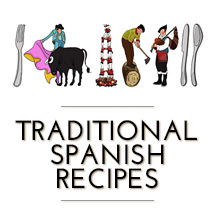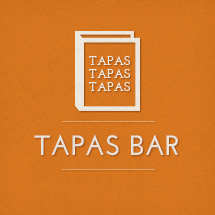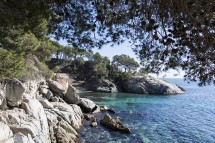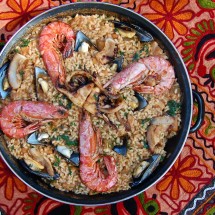
Jul 20
Sin categoría
Paella
•Ingredients: 200grs pork sausage, 200grs rabbit (could be chicken if you don’t like rabbit). 4 red shrimps, 4 prawns, 200grs. Clams, 1 cuttlefish. Half red pepper, half green pepper, 1 onion, 2 garlic cloves, 4 tomatoes, 150grs. Green beans (optional).
•1Kg. Mussels
•400grs. Rice, olive oil, salt, some parsley
•Ingredients for the fish soup: 300grs. Bone fish (any fish is ok), 1 tomatoe, 1 onion, 1 garlic clove and a third part of a monkfish head. Optional. You can use water instead or mussels water instead or a mix of fish soup and mussels water.
Get the PowerPoint recipe
Get the WebAlbum pictures
•First of all, don’t panic! It’s a bit complicated to perform a paella but if you are tidy and patient, you will make it!!!
•Put the mussels inside a pot with 2 fingers of watter in its bottom, cover the pot and when the mussels open take it away from the fire. The fire should be low all the time. Mussels that don’t get opened should be thrown away.
Leave the mussels apart and don’t throw away the watter inside the pot. We will need it for Paella.
•Use a big pan (teflon if possible) and pour some olive oil (see the picture) put the rabbit or chicken and the pork sausage in it. Salt it. The fire should be medium to high. Keep on stirring and turning the pieces so that they get done the same one side and the other.
When they get this colour, take them out of the pan and leave the meat in a plate.
•Proceed the same way with the shrimps and prawns. Salt them and have in the pan maximum 5 minutes. They taste better if they are not too done. Take them away from the pan and put them in a plate.
•Take the cuttlefish and wash it under the tap.Cut it in small pieces. Before you fry it, dry it with kitchen paper (it can jump out of the pan). Stir it for 15 minutes aprox until it takes out the water and changes its colour.
•Add the peppers and onion. Mix it all and stir the ingredients for 8 minutes aprox until the onion changes the colour and gets transparent.
•Here starts what we call sofrito the translation could be “Culin chopped onion and garlic fried in oil with tomatoe sauce”. It’s the most important part of the paella! If the sofrito comes out good, then the rest should also be good!!
•Throw the tomatoe sauce and the garlics in small pieces into the pan.
•Keep on stirring with a wooden spoon. Be patient. Don’t run. The fire should be medium all the time.
You will see that the tomatoe sauce seems to disappear in the pan. It gets oily and it gets darker. This is the signal that the sofrito is ready!
•Take the clams that have been all the time in water and salt to leave away the sand. Wash them and put them in the pan.
•In 5 minutes, more or less, the clams will be opened if you put the cover on the pan. After that take out the cover and stir the clams with the sofrito.
•When you have the clams the same way you see in the picture…
•Add the meat and stir up.
•Pour 100grs of rice per person. 4 persons are 400grs or 2 watter glasses. The fire should be medium/high.
•Mix all ingredients in the pan for 3-4 minutes with the wooden spoon.
•Add the fish soup to the pan. (8 glasses, same glass used for rice)
•The fish soup should be boiling when you add it to the pan.
•You should start with the fish soup in a different pot while you start the paella. If you do so, you will have both things ready when you need them. It’s very easy: take a big pot and put the tomatoe, onion, garlic, monkfish head and fish bones inside. Cover it all with water, let’s say, 3 or 4 liters. When it starts boiling take the foam away and count 20 to 30 minutes. The soup will be done then. Add the mussels watter in the soup pot. Keep the fire low so that its boiling when you need it.
•10 minutes after you added the fish soup to the pan, add the shrimps and prawns and some mussels.
•Leave it for 5 minutes and see if it needs more fish soup. If so, add a bit more. After that put the cover on the pan and leave for another 5 minutes.
•The paella is finished!! Don’t wait too long, if you do, the rice could be too soft. If you eat it too soon then it could be too hard. The timing it’s important! 20 minutes total since you throw the rice!
Comments






It’s wonderful to have found your blog and next time we make paella we will carefully follow your method. Do you recommend a certain type of rice, as to me, the main problem I have is with the rice we use. It seems to taste more like a risotto than a paella.
When cooking a paella the water/broth and rice percentage is important. Also, you add the water/broth one only time and to do a risotto you keep on adding everytime it evaporates and cooks. Also you shouldn’t stir a paella once you threw the rice and water/broth. And finally, the rice I use is either Bahia or Bomba (short and round grain)… However, it took me years to cook a good Paella!!! I think that is a question of experience, the more you try the better it results! Buen provecho!
Thanks for your help Nuria. We’ll come back to yours when we make it next and I’m glad to hear about Bomba as we can find that in our local supermarket. Hopefully, it won’t take us too many years to get it right, now that we’ve received your advice and have your great step by step instructions!
Hi Nuria, I actually made a paella at home adapted from several recipes including yours because I could not get all ingredients. And I need to use the garden runner beans that day which made me come to an idea of making paella.
Spanish food is one of my favorite cuisines esp tapas mainly because I used to hang around with a group of Spanish friends many years ago during my internship in Basel, Switzerland, and that was how I encounter Spanish food the first time.
Hola Janet! Thanks so much for telling me about it! I hope your paella was a success :D
It has taken me years of learning how to do it well. Plus, there’s so many versions of paella that it’s hard to perform the “original”.
The Valencia one (they say they are the inventors) has some beans in it, but they are special beans… you wouldn’t find them in Galicia (for example). Galicia is in the north west of Spain.
For me, the key is to keep on trying and experimenting :D. One day you will find your paella :D
Hi Nuria,
Your detailed instructions tempt me to try and make my first paella. I love paella but finding a good one (in a restaurant) is not really easy. Wish me luck and thanks for the recipe.
Hi V!
I wish you luck :D and if you have any questions or doubts you can always email me!
Nuria, very nice blog. My parents are both from Spain, my mother from Valencia, home of the Paella, and my father from Alicante. My cousins are living in Valencia and last year won, again, the first prize for paellla making. One point about your recipe… paella never, never should include an onion. It’s just not authentic, although I’ve seen many recipes in the US that advise using it.
Keep up the great work!
Welcome to my blog NJ. and thanks for your comment!
I know this thing about the onion, it’s only that I like it most with it. I’m sure you would like my paella too ;D even with an onion in it.
Hugs y recuerdos from Spain to your family. Best invention of all: Paella!
I came by your blog looking for a kickass ajoblanco recipe.
Thing is, when I come across a site that has paella I need to go check it out as it gives me an idea about how serious and knowledgeable the cook is.
I’m sorry, Núria. Your paella recipe, which you call “the traditional one” really, really isn’t.
I’m sure it’s very nice, but it’s a paella mixta the kind made for tourists (and I agree about the cebolla=nunca - it’s like saying add parmesan to a pasta marinara).
Perhaps you could change your description. I’m only disappointed because you call it a traditional recipe (I grew up eating paellas made with chicken, rabbit and snails cooked over orangewood and surrounded by the Alicantinian mountains… which is where my family is from)
Hola Maria,
Thanks for sharing your wiseness here :D.
Maybe you could enlighten me here and share your paella recipe instead of just critize my work!
Acording to Nestor Luján:
” La paella no es solamente el plato por el que se conoce a Valencia, sino también, por el que se conoce a España. Como toda fórmula regional, cuyo origen se ha perdido en el olvido, concebimos la paella como el plato resultante de la coción de arroz con los ingredientes que en cada población tienen más a su alcance, con la adición de la picada, preparación genuinamente mediterránea. Mucho se ha escrito y mucho se excribirá sobre este suculento plato, sobre la pureza de su elaboración original y sobre si se hace sólo con pescado o con carne, o con ambos elementos. Consideramos salomónicamente que sólo hay una: La que esté bien elaborada, la que guste al comensal y la que despierte y recuerde, en un qerfecto equilibrio, el sabor de cada uno de los ingredientes de que hemos dispuesto.”
In his recipe, to highlight what he just says, he adds i big onion, no snails and no garrofón.
My recipe was inspired in years of weekend familiar paella and his studied recipe.
I’m sorry for Néstor Luján but the origin of paella is very clear. Paella it’s from Valencia, exactly from the area surrounding the Albufera (http://en.wikipedia.org/wiki/Albufera) lagoon. And the ingredients are totally clear: rice, chicken, rabbit, green beans, Lima beans, tomato and saffron and as option vaqueta snails http://es.wikipedia.org/wiki/Vaqueta).
There are a lot of people that think paella is a spanish dish, but it’s valencian, without a doubt. In valencian language paella it means pan (http://ca.wikipedia.org/wiki/Paella_(estri)) and spanish people have invented the wor paellera to the paella pan because they didn’t know it.
Moreover valencian people never eat mixed paella and usually they think they are really disgasting.
One point it’s real, its’s very hard to find a restaurant with a good paella in Spain, but in Valencia it’s quite easy.
I love this recipe … deliziosaio I have a blog of Italian recipes but I like to try new flavors.Your blog is very nice … and good:-)